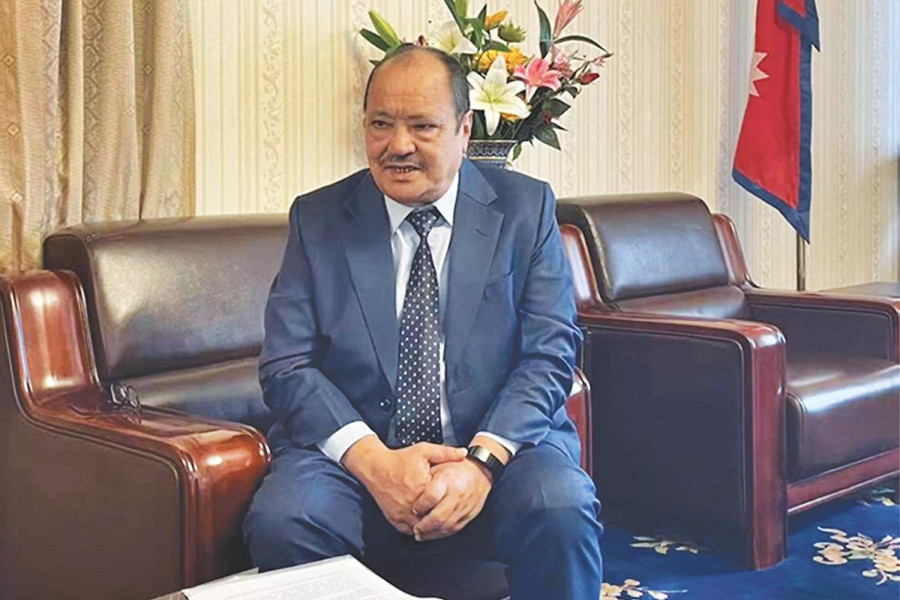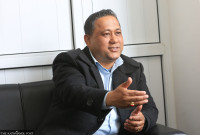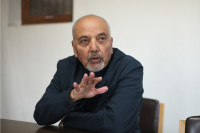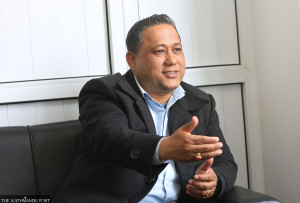Interviews
‘China’s projects don’t always get conducive environment in Nepal’
Bishnu Pukar Shrestha, Nepal’s ambassador to China, on BRI, new dimensions of Nepal-China relations and his experience in China.
Purushottam Poudel
With China on the brink of confirming Xi Jinping as the country’s president for the third consecutive term, Purushottam Poudel of the Post caught up with Bishnu Pukar Shrestha, Nepal’s ambassador to China. In this wide-ranging interview, the ambassador opens up on the Belt and Road Initiative (BRI), new dimensions of Nepal-China relations and his experience in China.
It has been seven months since you took charge as Nepal’s ambassador to China. How would you assess your tenure thus far?
It was somewhat difficult to work in the initial phase due to China’s zero-Covid policy. I could not meet many Chinese officials. Also, when I came here as ambassador, Nepali students who had returned to Nepal due to Covid-19 were unable to come back to China. Cross-border traders had trouble operating. Agreements between the two countries were put on hold.
Narayan Khadka, then foreign minister of Nepal, came to China shortly after my arrival. His visit was an opportunity for both countries to reiterate their commitment to implementing the agreements entered into since 2016. Soon after that, Nepali students began to travel to China to study. An effort has been made to open the land border which was closed due to the pandemic. We have also worked at enhancing air connectivity between the two countries.
During Khadka’s China visit, China announced 8 million yuan for Nepal. In December, we reached an agreement on this. We took the initiative to dispatch a team for a railroad feasibility study. Similarly, we took the initiative to build electric transmission lines between the two countries. To do so, a Chinese expert group travelled to Nepal and held meetings with the officials of the Nepal Electricity Authority. I met with the deputy administrator of the Chinese National Energy Administration after the Chinese team got back. During our meeting, the deputy administrator made an interesting suggestion.
According to him, a 220 KV power project can be built instead of a 400 KV line currently in discussion, as even the 200 KV line can produce 600- 700 MWh per hour and will be comparably cheaper to build. I have conveyed the message to Nepali officers.
We are also working on economic diplomacy. Recently, we conducted two forums on investment opportunities in Nepal. We have participated in different trade fairs and tried our best to showcase our products. Our efforts have focused on easing trade, tourism and transport.
Did the embassy follow up with the group who went to Nepal for the feasibility study of the railroad after they returned to China?
No, we haven’t. Those persons actually represent a government company. However, we are in contact with the China International Development Cooperation Agency (CIDCA), a state organ responsible for the project’s implementation. According to the information we’ve received from the CIDCA, the feasibility team that visited Nepal has filed a positive report.
The Pokhara International Airport was started well before China came up with its Belt and Road Initiative in 2013. But China now says the project is a part of the BRI. How do you see this issue?
The construction work of Pokhara International Airport started before the BRI came into being. With China declaring the airport as a project under BRI, I raised a question as to how Pokhara Airport can be so designated. We have been saying that China should not look at the BRI project only from the profit and loss point of view. But there is also no need for Nepal to raise any objections on this issue.
The fact remains that Nepal initially named 35 projects under BRI, of which nine were selected with mutual understanding. The Pokhara International Airport was not part of those selected projects.
The Pokhara airport is not a BRI project; that much is clear. As far as the nine projects under the BRI are concerned, first, there should be a mutual understanding over who will invest how much in the BRI. My point is that we should undertake development projects with financial assistance from everywhere.
It has been more than five years since we signed the BRI project. In this period, even the framework for project implementation under the initiative has not been formulated. Why?
We now refer to the “One Belt, One Road” initiative as the “Belt and Road Initiative”. The Chinese side claims that Nepal has been lethargic in providing necessary details about the projects to be implemented. But the Nepali side claims all necessary details have been provided. Setting aside these two claims, I’ve learned that Nepal has not adequately responded to Chinese inquiries on the details of the projects. But I also feel that China is reluctant to prioritise Nepal’s projects. Due to this, we have not started discussing how much money China will invest under the BRI in Nepal and how much Nepal will invest. Now we are in the process of approving the projects. We expect them to go more smoothly after that.
What is your view of the geopolitical struggle among big powers in South Asia?
It is important for us to understand which country looks at Nepal from what perspective. Apart from Bhutan, China has embassies of all other South Asian countries and it holds regular meetings with their ambassadors. When China wants to carry out developmental work in one country, there is no need for some other South Asian countries to feel insecure.
Do you think one reason for the poor progress of Chinese projects in Nepal is the vast difference in the governing styles of the two countries, with one being a one-party system and the other a multi-party democracy?
It is unfair to say China has a single-party system. China has multiple parties; it is just that the Communist Party of China is the dominant one. When questioning the ability of China, we must also accept that one reason China cannot work smoothly in Nepal is that we cannot give them a conducive working environment. That may, for instance, contribute to a Chinese contractor’s inability to finish a job on time. But there have also been cases where the Chinese have been at fault. The Budhi Gandaki project was taken up by the Chinese Gezhouba Company, however, they later left. Something similar happened with West Seti.
China still seems eager to work with Nepal’s communist forces. How do we interpret this?
A core communist belief is that communists around the world should unite. The Communist Party of China is no exception. There are many communist parties in Nepal as well, despite the fact that their slogan is the same. Even after the Maoists joined the peace process back in 2006, there was a call for Nepal’s major communist forces to unite. During the 2017 legislative elections, the endeavour to unite the big communist parties of Nepal finally materialised.
But the union could not last for two reasons. One, the leaders could not manage the unity internally, and on the other, some external forces tried to undo the unity. So the Nepal Communist Party broke up. China has been suggesting that the communist parties again work together, but that does not mean it is interfering. I also don’t think the Chinese are using any kind of force to bring about another communist unity in Nepal.
As a member of a communist party yourself, how do you compare the communists of Nepal and China?
The two sets of communists have similar philosophies. For instance, there is a two-line struggle within the Communist Party of China as well. An intra-party struggle was seen some time ago on whether to maintain the zero-Covid policy. I would say the communists in China are more disciplined than those in Nepal. But more than that, it would be hard to compare the two lots.
In Nepal, the resident ambassadors can easily meet high-ranking officials, even the President and the prime minister. Not so here. Even after seven months, you have not been able to present your credentials to President Xi.
Yes, I am yet to present my credential certificate. There are embassies from more than 175 countries here. As a result, it is improbable that ambassadors from all countries will get easy access to high-ranking officials. Occasionally, I also tell Chinese officials that it should be easier for representatives of other sovereign countries to meet high-level people of their country.
The Chinese respond that if any of our work is interrupted, it is a separate problem, or else it is difficult to manage time for their high ranking officials. Anyway, they are trying their best. When I arrived here as an ambassador, I had an opportunity to meet Wang Yi, who was then the foreign minister. I also got to meet the new Foreign Minister of China, Qin Gang. Also, what you have to remember is that we can start working as ambassadors in China after we present our credentials to the chief of protocol of the Chinese foreign ministry. This is unlike in Nepal when you can work only after presenting your credentials to the President.




 16.29°C Kathmandu
16.29°C Kathmandu













